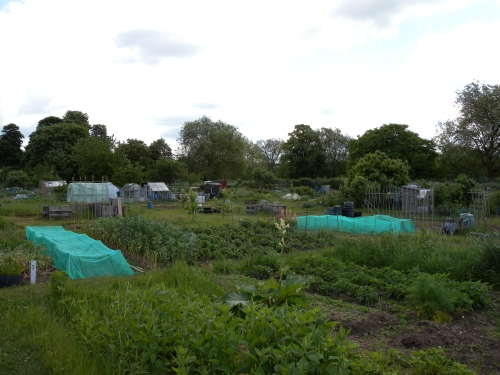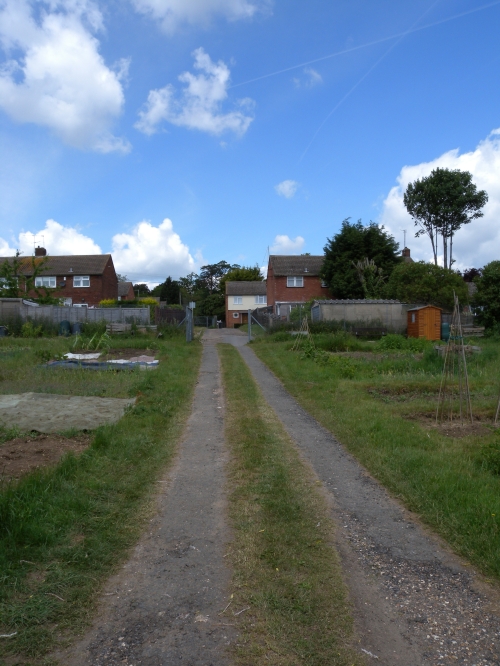The development of Coley Park, and other estates around Reading, that took place in the 1950s required the proper provision of allotments for its residents and Coley Allotment Gardens are the result of that policy. However the story of Coley allotments is much less straightforward than this statement suggests.
Plans for development in the area began before World War II. At that time there were private allotments between St Saviour’s Road and Holy Brook and on Shaw Road. In May 1939 there were a total of 142 tenants; 34 on the former and 108 on the latter site. The land that the Allotments and Small Holdings Committee wanted to acquire was building land, which at £400 to £600 an acre was more than the Finance and General Purposes Committee was prepared to pay. The Berkshire Chronicle heading “ALLOTMENTS AT BUILDING SITE PRICE”, “QUESTION OF PRINCIPLE”, sums up the discussion perfectly (1).
Coley Park allotment tenants already had the attention of the Council. In September 1938, the Mayor, Councillor P.E.Langston, opened the Coley Allotments Holders’ Show at St Saviour’s Hall. He was reported as saying, “There was a little danger of the Coley Allotments going, but he thought they would be able to do something about that and he would give them hopes that they would not lose anything.”. The President of the Society was the Reverend George Raymond Webster (2). The next month’s coverage of Council proceedings quoted Councillor William McIlroy, “The land he had in mind had been allotments he believed for 100 years, and there were instances where men had inherited from their fathers and had been in occupation over 50 years.” (3).
In the 1930s, the Council embarked on a series of slum clearances which included areas of Coley. So, in the 1939 discussions it is interesting to hear what the Councillors are reported as saying. “Councillor Lewis said that Coley, despite the fact that many houses had been pulled down, was still a very congested area, and had very narrow streets. People in Coley could not afford to travel long distances to allotments, and in some cases cycling long distances was out of the question.” Then followed the Deputy-Mayor (Councillor Langston), “…I think it would be a severe hardship to these good people of Coley to lose their ground. Coley is a very old part of Reading, and the least colourful. I was going to say drab, but it is not so drab as it used to be. I think this amenity for that district is for the good and the health of the people.” Some amusement was caused when Alderman Mrs Jenkins asked Councillor Smart, who had described himself as such, what “an allotmenteer” was. His opinion on the matter under consideration, was that if the allotments were taken away, “The people would have to find other means to utilise their spare time – not so profitable perhaps, as spending it on allotments.”. The result of the deliberations was that the matter was referred back to the Finance Committee (4).
Ultimately, the outbreak of war halted the immediate prospect of building development. Coley Allotment Holders Association became members of the Federated Horticultural and Allotment Association of Reading in 1941 and tenants continued to enjoy their allotments (5). During the war, the Berkshire Chronicle reports on their annual shows held at the end of the each summer (6).
Post war, a new association was formed and in 1948 the Coley Gardeners’ Association joined Reading Horticultural Federation (as the wartime Association was then called)(7). At the June 1952 committee meeting, the secretary reported that Mr Bucknell (owner of the land) had told him that the allotments were to be taken over by the council. Protest letters to the Ministry of Agriculture and Fisheries and the Council were planned and they requested the support of Reading Horticultural Federation. Their concern was that they should not have to vacate their existing plots until the new site was ready for cultivation (8). The president of the Allotments and Small Holdings committee, Councillor Dorrell had been made vice-president of the Association in 1951 and appears to have continued in that position until he became president in 1956. At the AGM in January 1954 he addressed the members, assuring them of the efforts being made by his committee on their behalf (9).
The Association was formally wound up in 1960 and its books, records and bank balance of £12 16s 3d (£12.81) were handed over to Reading Horticultural Federation (10). The Secretary’s report for 1956 (which would have been given at the 1957 AGM), records, “…a year of tension and matter of hanging on…”. In September, the new site had been taken over by the Council. Looking forward, the Secretary proposed that, “…the finest way to repay the Allotment Committee of the town council, Reading Horticultural Federation and past and present officers is by keeping a vigorous association.”(11).
Between 1948 and 1960, the Association committee generally met at the Brickmakers Arms on Wolseley Street (closed in 1959) (12). Formal occasions such as the AGM and lectures were usually held at St Saviour’s Hall (13).
Preference for the new allotments “Coley Park Allotments” was to be given to tenants who had lost their plots to building. The rent set in 1956 was 1s 0d (5p) per pole per annum (14).
The Churches In Reading Drop In Centre (CIRDIC) is based in St Saviour’s Church Hall on Berkeley Avenue. Given the past strong links between St Saviour’s Hall and Coley allotments it is fitting that this continues with the CIRDIC allotments at Coley. The centre has a volunteer professional head gardener. The aims of the plots are twofold; to provide an activity for guests at the centre of working on the allotment and to provide vegetables for the meals prepared in the CIRDIC kitchen (15).
FACT PANEL
| No. of plots: (16) | 41 |
| Full plot equivalent: (16) | 32.6 |
| Date allotments established: | 1956 |
| Date taken on by Council: | 1956 |
| Previous use: | farmland / open land |
| Status: (17) | Statutory |
References
(1) Berkshire Chronicle 5 May 1939. (Report on Council Meeting). Reading Library, Local Studies Collection.
(2) Berkshire Chronicle 9 September 1938. Reading Library, Local Studies Collection.
(3) Berkshire Chronicle 7 October 1938. Reading Library, Local Studies Collection. Councillor McIlroy represented Minster Ward.
(4) Berkshire Chronicle 5 May 1939. (Report on Council Meeting). Reading Library, Local Studies Collection.
(5) Berkshire Chronicle 28 February 1941. Reading Library, Local Studies Collection.
(6) Berkshire Chronicle, for example 11 September 1942, there is a report on the 20th show. Reading Library, Local Studies Collection.
(7) Garden Topics 2 June 1948. Reading Library, Local Studies Collection.
(8) 5 June 1952. Coley Gardeners’ Association minutes. D/EX 1820/2/1/2. (BRO)
(9) 26 January 1954, AGM. Coley Gardeners’ Association minutes. D/EX 1820/2/1/2. (BRO)
(10) Coley Gardeners’ Association minutes. D/EX 1820/2/1/2. (BRO)
(11) Coley Gardeners’ Association. Report of the Secretary 1956. D/EX 1820/2/2/1/2. (BRO)
(12) Coincidentally an article recently appeared in the Reading Post, with an old photograph of the pub. http://www.getreading.co.uk/community/s/2121462_getback_seaside_outing_from_the_brickmakers_arms. Accessed 25 October 2012.
(13) Coley Gardeners’ Association minutes. D/EX 1820/2/1/2. (BRO)
(14) Allotments and Small Holdings committee minutes 15 October 1956. R/AC1/3/121. (BRO)
(15) I am grateful to Mabel Boyd, her staff at CIRDIC for spending some time talking to me about their allotment. http://www.cirdic.org.uk.
(16) November 2008 Report to the Green City and Open Spaces Forum, 19 November 2008. Allotment Provision and Plan Update. Director of Environment Culture and Sport.
(17) Reading Borough Council 2005 Allotment Plan.
© Evelyn Williams 2012
PDF here:26 Coley Park





